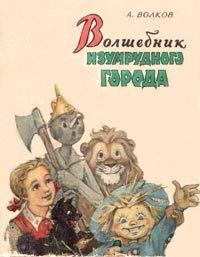8.8 /10 1 Votes8.8
Originally published 1939 Country Soviet Union | 4.4/5 Goodreads Publication date 1939 Illustrator Leonid Vladimirski | |||||||||||||||||||||||||||||||||
 | ||||||||||||||||||||||||||||||||||
Original title Волшебник Изумрудного Города Followed by Urfin Jus and his Wooden Soldiers (1963) Adaptations The Wizard of the City of Emeralds (1974) Similar Alexander Volkov books, Fantasy books | ||||||||||||||||||||||||||||||||||
The Wizard of the Emerald City (Russian: Волшебник Изумрудного Города) is a 1939 children's novel by Russian writer Alexander Melentyevich Volkov. The book is a re-narration of L. Frank Baum's The Wonderful Wizard of Oz. Baum's name is sometimes credited in the book (in the appendix by Volkov, which is found in some editions, where Volkov describes the origins of his book). The names of most characters are changed, some elements of Baum's novel are removed, and some new elements are added. The book was illustrated by Leonid Vladimirski in 1959 and became quite popular in the 1960s, leading to five sequels: Urfin Jus and his Wooden Soldiers (1963), The Seven Underground Kings (1964), The Fiery God of the Marrans (1968), The Yellow Fog (1970), and The Secret of the Abandoned Castle (1975, published in 1982). These sequels were written by Volkov himself and are not based on Baum's plot elements, although we do encounter the powder of life, a character called Charlie Black who is not unlike Cap'n Bill, intelligent foxes, and the use of a Sandboat similar to Johnny Dooit's, albeit with wheels.
Volkov's Magic Land series, as it was called, was translated into many languages and was popular with children all over the Eastern Bloc. Volkov's version of Oz seems to be better known than Baum's in some countries, for example in China and the former East Germany. The books in the series have been translated into English — or retranslated, in the case of the first book — by Peter L. Blystone, and were published by Red Branch Press in three volumes (two books per volume) in 1991 (revised edition 2010), 1993, and 2007. A very important reason for the success of these books were the illustrations by Leonid Vladimirski.
Notable differences between "The Wizard of the Emerald City" and the original book "The Wonderful Wizard of Oz"
The English edition (translation) together with the first sequel is Tales of Magic Land 1.
